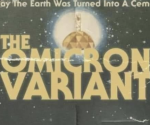Be not surprised: Trump pledges continuation of “war-system alternative” space scam
Donald “Hong Kong Phooey” Trump did it again. Boasting about bigger nuclear buttons is all too easy for an indecorous buffoon: “who lives in a gold-plated house like this?” is how Lloyd Grossman would have introduced him on the 80s TV show, Through the Keyhole. The Koreans got scared by Trump’s big mouth – the two governments on the peninsula started serious diplomacy that could result in reunification. The Americans could not have any of that, so they had to recapture the initiative, and gain a position from whence to spoil in the future. It might be too late; the South Koreans may have crossed that Rubicon whereby a US military presence is no longer tolerable. And so to heap praise on Donald Trump for so-called peace talks with Kim Yong-Un is to take a share in his fumbling.
On the other hand, the most significant event in the last fortnight involving Donald Trump was when he announced plans for the formation of a “space force” for “American dominance of space”. As if it wasn’t causing enough death and destruction on the land, sea and from the skies, now no plane of creation is going to remain undefiled by the presence of the murderous US Military – at least, so they tell us. A BBC White House reporter, Tara McKelvey, was present in the East Room when Trump enthused about “Moon, Mars and Worlds Beyond”: “People in the back of the room started to laugh”, she reveals. Corporate-media journalists should know better than that. A joke it may be now, but in the future, when the US Military trots out high-production Hollywood movies purporting to be real footage of space battles, corporate-media journalists will straight facedly tell their befuddled audiences that, following the enemy’s sneak attack on the Lunar Base that started the war, Buck Rogers and the US Cyclone Rangers will be facing the threat of the Space Ayatollah and his AK-47 clutching, jabbering Lunatic Muppet horde, from their crater bases in the Sea of Tora Bora on the far side of the Moon, for an undeterminable period into the future in a new sort of conflict the likes of which the world has never seen before.
American space exploration has never been what it appears to be, and this latest adventure is just the latest instalment. There is a slim chance that the US Government, finding its military trailing behind Russia in every aspect of modern warfare technology, thinks that if it throws out a red herring, then its enemies will set off in pursuit, and waste money doing it. However, it is more likely to be just more of the same old same old: a space programme to act as an enormous sink hole for tax revenue, and to condition people into thinking that a military threat, provoking global unification and a world government, could come from outer space.
The material that is required reading for anyone who wants to understand what NASA is for has been introduced at FBEL before in the articles, “Silent Weapons for Quiet Wars”; Part One: “Inductance” for economic dominance (link), and A report on the “Report from Iron Mountain” – introduction (link), although these themselves did not get into the place for a wasteful space programme in a war-system alternative.
Basically, to combine the two sources that each article inspects, and treat the crux of the issue all together, war serves an important function in the control of human society. A new phase in the application of that control would see the necessity for war diminish (as nations disappear to be replaced by World Government). So, “to successfully enact peace”, as the author wrote previously, “the war systems must be replaced by substitutions that perform the same function in society”.
The following is from Silent Weapons for Quiet Wars:
Other large alternatives to war as economic inductors or economic flywheels are an open-ended social welfare program, or an enormous (but fruitful) open-ended space program.
To recap, an “inductor” in the system portrayed in this pamphlet was the kinetic storage of the wealth of a few who had monopolised capital. In real terms, it was the masses – the consumers – in their interaction with the product of capital. In the face of an input capital failure, the return flowing out of this component back to the capital owners could be guaranteed by reducing the inductance – in other words, killing the population off in a war. So, an “open-ended” space program is an economic tool for preserving hegemony. More detail is supplied in the Report from Iron Mountain:
Another economic surrogate that has been proposed is a series of giant “space research” programmes. These have already demonstrated their utility in more modest scale within the military economy. What has been implied, although not yet expressly put forth, is the development of a long-range sequence of space-research projects with largely unattainable goals. This kind of programme offers several advantages lacking in the social welfare model. First, it is unlikely to phase itself out, regardless of the predictable “surprises” science has in store for us: the universe is too big. In the event some individual project unexpectedly succeeds there would be no dearth of substitute problems. For example, if colonisation of the moon proceeds on schedule, it could then become “necessary” to establish a beachhead on Mars or Jupiter, and so on. Second, it need be no more dependent on the general supply-demand economy than its military prototype. Third, it lends itself extraordinarily well to arbitrary control.
Space research can be viewed as the nearest equivalent yet devised to the pyramid-building, and similar ritualistic enterprises, of ancient societies. It is true that the scientific value of the space programme, even of what has already been accomplished, is substantial on its own terms. But current programmes are absurdly obviously disproportionate, in the relationship of the knowledge sought to the expenditures committed. All but a small fraction of the space budget, measured by the standards of comparable scientific objectives, must be charged de facto to the military economy. Future space research, projected as a war surrogate, would further research, projected as a war surrogate, would further reduce the “scientific” rationale of its budget to a miniscule percentage indeed. As a purely economic substitute for war, therefore, extension of the space programme warrants serious consideration.
Of special interest to the FBEL audience should be the equivalence made between ancient monument building and space research. What else is a NASA rocket other than a Tower of Babel? The aspect of space research as a folly and a monument designed to inspire in the masses awe and submission for the technocratic class, and also as a metaphor for Luciferian evolution, has also been explored in articles such as Hairspray, wire and harnesses; NASA’s role in the NWO (link) – which offers a nice segue to the second half of this article, which serves as a reminder – much needed in the face of Trump’s idle boasting about “return[ing] Americans to the Moon” – of the indicators that tell of Americans never having gone in the first place. Eventually, what follows will be transcribed in a fuller form to further extend the work that is hosted at FBEL.co.uk, Apollo 11’s Magic Window; Faking the Earth, where evidence indicating that the “astronauts” used back-projection to create phantom images of the Earth forms the central issue.
The information isn’t new – it’s just that the author has newly come across it. It concerns a change of mind about the environment of space that affects travel to the Moon, though this kind of thing has been met before regarding the problem of heat. To touch briefly upon it: it appears to the author that the story about Apollo 11 cooling has had to change to deal with simple criticism. It used to be that heat was “radiated” away into space on a “cold” side of the craft, and due to a silver coating, was “reflected” away on the side facing the Sun. Moreover, antifreeze pumped through the craft removed heat generated by instruments and took it to external “radiation” panels. Sceptics pointed out that space was not cold; supposedly the ignorant had been meant to conflate radiation with conduction.
Nowadays there is definitely an emphasis from Apollo-apologism on the idea that the craft got rid of its heat through the radiation of infrared light away from the craft into the darkness of space. But a problem remains. The ability to emit radiation is dependent on something called the emissivity coefficient of the material, and also its surface temperature. The emissivity coefficient of highly polished aluminium, of which the Apollo craft were constructed, is as low as 0.04 (on a scale of 0 to 1, where 0 is a perfect reflector), although it gets higher when the material is hotter. Crucially, the ability to emit radiation is essentially the same as the ability to absorb it; a black object, with an emissivity coefficient of 1, retains a lot of the heat that it absorbs, as experience and intuition informs. Thus, the figures for the Apollo craft clearly indicate that even the reflective surfaces on the vessel could not prevent all absorption of heat energy from the Sun – which involves a colossal 64,200,000,000 W/m² (Watts per metre squared). Obviously, even a little bit of this means a great deal of heat, which accumulatively makes reflection less likely, which then increases absorption of radiation – which conducts as heat into the fabric of the craft, heats the air and the instrumentation, and then is somewhat trapped because the Apollo 11 couldn’t radiate heat away very efficiently on its own, and wouldn’t have been able to carry enough coolant material to keep ejecting into space – yes, about that: nowadays it appears that the Apollo cooling system worked by having heat-carrying liquid sublimating into space by exposure to the vacuum; in other words, ice is evacuated into space. But there is a problem with this because it implies an open system where the heat transfer medium would continually be lost – with no apparent means to replace it. The truth is this: the Apollo craft would have got hot, continued to get hot, and wouldn’t have been able to cool. A sausage turning on a barbeque is how it has famously been described.
There is a point in the space between the Earth and its moon where the gravitational pull from the one equals the same from the other. This is called the “neutral point”. Before the “space age” it had been calculated by figures ultimately derived from a few supposedly known pieces of data: the masses of the Earth and Moon. The Moon’s surface gravity was found to be one-sixth of the Earth’s. This put the neutral point between the two bodies at a range of 22,025 to 25,193 miles from the centre of the satellite.
With Apollo 11, all this changed, as indicated by the salvaged Nazi scientist, Wernher von Braun: “At a point 43,495 miles from the Moon, lunar gravity exerted a force equal to the gravity of the Earth, then some 200,000 miles distant” (Time Magazine, July 25, 1969). In 1973, the Encyclopaedia Britannica published a figure of 39,000 miles for the neutral point – significantly, the same authoritative source had, in 1960s versions of its books, put out a figure from within the old range. A new range for the neutral point that fell between 38,000 and 43,495 miles from the Moon’s centre (depending on the source) would mean that the Moon’s surface gravity would have to be much larger than that which the activity of the Apollo mission had been predicated upon, and indeed executed according to. In other words, the Moon’s surface gravity is at least 64% of the Earth’s, and Apollo went about business as if it was 17% – and relies on no one understanding the significance. Basically stated, the extended neutral point would mean arriving at the Moon at a greater velocity – which would be required so as to avoid falling into the surface. If NASA claims that the Apollo craft got to the Moon under 17% gravity conditions, then it wouldn’t have been travelling at a sufficient rate of speed.
The neutral point is also significant for the progress of a craft between the Earth and Moon, because it is the point in its journey where it starts to accelerate. All sorts of factors rely on knowing where it is. The fantastic rate of early lunar probe failure is a clue that the space age got embarked upon on the basis of a theory about this environment that experience soon rendered redundant. On the 6th attempt in a year, the Soviets had their first fully successful mission in September 1959, when Luna 2 crash landed on the Moon (as intended). Luna 3 followed, with a fly past in October of the same year. In 1960, after two failed missions, the Soviets withdrew from the game for nearly 3 years, and on re-entering, continued to fail until February 1966 when Luna 9 became the first vessel to soft land on the surface (the Zond 3 flew by the Moon in July, 1965, but apparently there is suspicion that it was intended as a Mars probe). In all, the Soviets had launched 20 probes prior to Luna 9.
The USA failed from August 1958 to February 1964 when Ranger 6 crash landed on the Moon (as intended), although it sent no proof that it had. There had been 12 NASA missions prior to this, one of them, Pioneer 4 (March 1959) went into solar orbit after a very distant flyby of the Moon – in no way should it be called a successful Moon probe. The Rangers 7 to 9 (July 1964 to March 1965) crash landed on the Moon, and sent back images. And then, after the Soviets had also managed to put the first craft into a Lunar orbit (Luna 10 – April to May, 1966), the Americans – with no intervening missions since Ranger 9 – caught up with the Soviets in one fell swoop with a managed landing (soft landing) and an entry into orbit with Surveyor 1 (June 1966) and Lunar Orbiter 1 (August to October 1966).
Between Surveyor 1 and Apollo 11, the Soviets only attempted one landing mission: the Luna 13. It succeeded, and took pictures, and measurements of the soil. As for the Americans, Surveyors 2 and 4 crashed. Surveyors 3, 5 and 6, however, landed and performed studies supposedly in support of the forthcoming Apollo missions. Surveyor 7, of January and February 1968, was the last probe lander that NASA sent to the Moon. In contrast, from February 1969 onwards, the Soviets sent 15 missions that were intended to perform managed landings – they had extremely mixed results. Significantly, six missions up to September 1970 that were designed to retrieve soil and bring it back to Earth all failed. Only one got off the Earth – and it crash landed on the Moon. Contrast with the Zond missions, which were flyby missions that would return to Earth with managed landings: three successful outings in the same time frame.
Does the evidence suggest that the Soviets had problems with the additional weight required for escaping the Moon’s real gravity? (More fuel would be required, meaning a greater payload, and a heavier combination to have attempt leave the Earth’s influence). Notice that the Americans never had a craft return from the Moon until Apollo – the Surveyors didn’t do that. Even the Lunar Oribters (there were four subsequent ones after the first) crashed into the surface of the Moon after they had completed their missions. In July 1969, after only five “successful soft landings” on the Moon, none of which returned to Earth, the Americans could suddenly land and return a crew of men?
If we want a truer picture of human exploration of space, we should stick to examining the Soviet experience – and the evidence in this respect might very well suggest that the Soviets performed a reset in 1960, possibly applying the empirical data regarding a new neutral point, and then fine tuning for three further years. In 1964, the Americans were nearly 5 years behind the Soviets. By the end of 1966, it had caught up. The author proposes that it was at some point after the Ranger missions that the Americans realised that they wouldn’t achieve the target for manned Moon missions set by Kennedy in 1962, and would not be surprised if the Surveyor missions were faked; it would be the beginning of a great NASA tradition. Yes, NASA is able to produce images of the Moon’s surface where it says Surveyor craft are visible – but on the other hand, NASA is a liar, and a faker.
Up until Apollo 11, NASA excelled at collecting images of the Moon, but not a lot else, and the people at Disney who had to make that giant mock-up of the Lunar surface would have benefited enormously. What a marvellous irony it is that in 2018, Disney makes space fantasy adventure movies having acquired and ruined the Star Wars franchise. No doubt when the time comes, the skills involved in making space movies will be transferred to bringing us news of the derring-do of the US Cyclone Rangers.
[Featured image is a still from Placeboing’s The Trump Dimension].


















